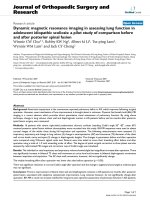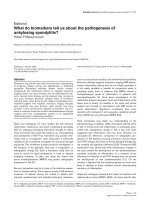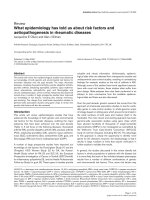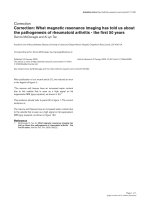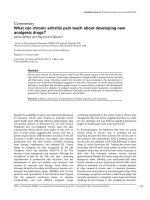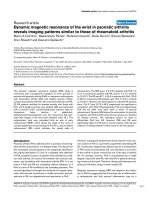Báo cáo y học: "What magnetic resonance imaging has told us about the pathogenesis of rheumatoid arthritis - the first 50 years" doc
Bạn đang xem bản rút gọn của tài liệu. Xem và tải ngay bản đầy đủ của tài liệu tại đây (512.13 KB, 7 trang )
Page 1 of 7
(page number not for citation purposes)
Available online />Abstract
Modern imaging modalities, including magnetic resonance imaging
(MRI), are valuable diagnostic and therapy monitoring tools in
rheumatoid arthritis (RA). This article reviewed how these imaging
modalities have greatly improved our understanding of pathogenic
mechanisms in RA, namely the link between inflammation and
damage. For example, traditional paradigms regarding the mecha-
nisms of joint destruction, including the idea that synovitis and
damage are uncoupled, have been challenged. As the power of
MRI increases, there is a need to define normality since apparently
normal joints occasionally exhibit MRI evidence of synovitis in the
absence of symptoms.
Introduction: a historical perspective
Historically, subjects with rheumatoid arthritis (RA) presented
relatively late for specialist rheumatology assessment
following the failure of anti-inflammatory agents. Patients
were eventually treated with disease-modifying therapies
such as gold and penicillamine, which were of limited efficacy
in comparison with modern therapeutic standards. Taken
together, this delayed presentation and relative inefficacy of
therapies meant that many patients had quite florid joint
destruction at clinical presentation. The gold standard clinical
imaging modality for RA is projection radiography (x-ray), in
which periarticular osteopenia, joint space loss, and marginal
erosion are noted to be commonplace. Of these abnor-
malities, marginal erosions came to be viewed as a specific
and relatively sensitive diagnostic test and were adopted by
the American College of Rheumatology as classification
criteria for RA in 1987 [1].
Projection radiography therefore has placed the marginal
erosive process centre stage in disease and has led to the
idea that joint erosion and synovitis are often uncoupled
(Table 1). This concept emerged because the relationship
between joint swelling and joint destruction was not linear,
since erosion progressed when synovitis was apparently
treated [2-4]. Such clinical observations helped spur cellular
and molecular investigations that revealed that an apparent
uncoupling process was linked to synovial fibroblast
transformation in which such cells were shown to destroy
cartilage in a manner that was autonomous of inflammation
[5]. At the dawn of the era of biological therapy in RA, this
theory led to the concept of a dual-therapeutic strategy,
including anti-inflammatory biological therapy, on one hand,
and antineoplastic type drug strategies, including metallo-
protease inhibition, on the other [6].
Despite the worldwide recognition of projection radiography
as a relatively easily available imaging tool for RA, patients
now present early, at the stage when projection radiography
is normal in the majority of cases. This has driven the need for
alternative imaging modalities for the assessment of early
arthritis. Magnetic resonance imaging (MRI) has been
recognised since the 1980s as a promising imaging tool in
evaluating musculoskeletal disorders [7]. The remainder of
this article deals with how MRI has challenged RA patho-
genic concepts and how this has far-reaching implications.
How magnetic resonance imaging changed
the way we view rheumatoid arthritis
Joint failure is the final common pathway of an array of
inflammatory, crystal, and degenerative arthritis. The advan-
tage of seeing patients early in the course of disease is that
abnormalities evident in imaging are likely to be primary rather
than secondary. Unlike projection radiography (which could
essentially show only bone), MRI has unparalleled tomo-
graphic capabilities and can define different soft tissue struc-
tures within the joint, including the ability to clearly depict
synovitis following the administration of the MRI contrast
agent gadolinium-DTPA (Gd-DTPA) [8]. Ultrasound also
brings with it excellent spatial resolution capabilities and the
Review
What magnetic resonance imaging has told us about the
pathogenesis of rheumatoid arthritis - the first 50 years
Dennis McGonagle and Ai Lyn Tan
Academic Unit of Musculoskeletal Disease, University of Leeds and Chapel Allerton Hospital, Chapeltown Road, Leeds, LS7 4SA, UK
Corresponding author: Dennis McGonagle,
Published: 10 October 2008 Arthritis Research & Therapy 2008, 10:222 (doi:10.1186/ar2512)
This article is online at />© 2008 BioMed Central Ltd
Gd-DTPA = gadolinium-DTPA; MCP = metacarpophalangeal; MRI = magnetic resonance imaging; OA = osteoarthritis; PMR = polymyalgia
rheumatica; RA = rheumatoid arthritis; SpA = spondyloarthropathy.
Page 2 of 7
(page number not for citation purposes)
Arthritis Research & Therapy Vol 10 No 5 McGonagle and Tan
ability to visualise soft tissue and also erosion at quite high
resolution, but unlike MRI, ultrasound is unable to ascertain
pathologies taking place within the bone. Historically, papers
dealing with MRI in rheumatology devoted considerable
space to the technology and methodology because there
were very few relevant data accrued using this modality.
However, since there is now such a wealth of imaging data
available from MRI, the present article will focus on it.
Magnetic resonance imaging determined
bone erosion and bone oedema in
rheumatoid arthritis
The original studies of MRI showed that it is more sensitive
than projection radiography for the detection of erosions,
particularly in the wrist joints [9,10]; however, at the outset, it
was not clear whether radiographic and MRI erosions repre-
sented the same pathological processes. Not surprisingly, the
tomographic nature of MRI has been used to show that
erosions are more commonly detected compared with
radiography at several sites, including the metacarpophalan-
geal (MCP) joints, shoulders, odontoid peg, knee, and feet [11-
16]. Unlike erosion formation in small joints, studies to date
using MRI have not proven to be beneficial for the assessment
of articular cartilage loss in small joint disease in RA [17].
The advent of fat suppression MRI allowed rheumatologists
to appreciate a new joint abnormality that was hitherto
unrecognised in RA, namely periarticular bone oedema.
Unlike erosions, this abnormality can be quite diffuse and may
involve the entire MCP head. The administration of Gd-DTPA
combined with fat suppression sequences strongly
suggested that this represented an inflammatory process or
an osteitis (Figure 1). Indeed, this has been confirmed
histologically by evaluating tissue obtained at small joint
arthroplasty in chronic RA where bone oedema lesions were
identified prior to surgery [18].
In practice, MRI bone erosions may be associated with an
extensive halo of bone oedema. Historically, bone oedema is
seen on fat suppression MRI sequences, but particularly
severe bone oedema in which there has been extensive
replacement of marrow fat may be evident on T1-weighted
sequences. MRI erosion and bone oedema are intimately
linked from the pathophysiological perspective. Bone oedema
may regress following therapy with corticosteroids and
methotrexate or following biological therapy. Hence, the
regression of severe bone oedema lesions (evident even on
T1-weighted imaging) has been taken as evidence for healing
of erosions [19] (Figure 1). Strictly speaking, this is not true
healing; this apparent repair (in reality, the resolution of
inflammation) is in no way the same as healing of
radiographic erosions where frank bone recortication may
occur (Figure 2). These MRI features, in fact, depict the
reversal of a preradiographic abnormality. However, the
natural history of untreated MRI bone oedema is the subse-
quent development of radiographic erosions [20]. It has been
fairly conclusively shown that MRI bone erosions are also
associated with a cortical break as depicted by high-
resolution ultrasound and computerised tomography confir-
ming that they represent the same disease process [21,22].
Synovitis and associated extracapsular
changes in rheumatoid arthritis and other
arthropathies
The ability of MRI to demonstrate synovitis in RA is the
greatest strength of this method over projection radiography.
The presence of synovitis can be inferred best on T2-
weighted sequences based on increased joint fluid and
confirmed using Gd-DTPA, which has greatly improved the
accurate quantification of synovitis. Several studies have
shown that MRI synovitis correlates extremely well with
histological grades of synovitis, including tissue vascularity
[23,24]. A number of approaches to assess synovitis can be
Table 1
Traditional model for rheumatoid arthritis (RA) based mainly on radiographic findings and modern concepts emerging from
magnetic resonance imaging in RA
Traditional paradigms for RA Modern imaging paradigms
Erosions A relatively late feature Present in the majority at clinical presentation
Synovitis and damage Synovitis not necessarily linked to damage – uncoupling Linear link between synovitis with damage
Erosion mechanism Immunologically mediated or autonomously by Major biomechanical contribution – such factors may
synovial fibroblasts mechanically uncouple synovitis from damage.
Cutting edge of erosions Synovial fibroblasts and osteoclasts destroy tissue Recognition that magnetic resonance imaging bone
from outside in. oedema represents a diffuse osteitis – at least some of
erosive process occurs within the bone.
Synovitis locations Considered as diffuse Regional variations within and between joints
Pathophysiological Erosion formation and cartilage pannus junction Erosion and pannus are inevitable and predictable
perspective key to understanding RA consequences of chronic synovitis, RA being the most
common cause.
Page 3 of 7
(page number not for citation purposes)
used, including the quantitative measurement of synovitis by
the evaluation of its thickness in millimetres, calculation of the
volume of a given slice, or estimating the entire joint volume
[25-27]. Alternative qualitative methods have also been used,
including the dynamic measurement of the initial rate of Gd-
DTPA enhancement and maximal enhancement, both of
which are useful surrogates for the degree of synovial
vascularity [28,29]. Generally, there is a correlation between
the severity of synovitis and all of these parameters.
Whilst joint inflammation is conceptualised in relationship to
synovitis in RA, studies have shown that severe synovitis is
Available online />Figure 1
Coronal magnetic resonance imaging (MRI) of the metacarpophalangeal (MCP) joints. (a) T1-weighted image from the MCP joints in early
rheumatoid arthritis, and (b) corresponding fat suppression image at baseline. (c) Corresponding T1-weighted image at 6 months, and (d) fat
suppression image at 6-month follow-up. The diffuse low signal at sites of MRI erosion in (a) (arrows) is better demarcated in (c) (arrowheads). The
osteitis process at the 2nd, 3rd, and 4th MCP heads in (b) (arrows) has either improved or dramatically regressed in (d) (arrowhead). These
images depict the inflammatory component to the MRI erosive process.
Figure 2
Model for understanding the link between radiographic and magnetic resonance imaging (MRI) erosion. (a) A diagrammatic ‘chessboard’ model of
a normal joint. The white squares depict the calcium-containing tissues on radiography. The black squares depict the soft tissues that are ‘invisible’
on radiography but that are visible on MRI due to their hydrogen atom content (fat or water on TI-weighted images and water on fat suppression
images). (b) Radiographic erosion where bone cortex and trabecular bone are lost, hence the x-ray appearance of a ‘hole’ in the bone. Though not
visible on x-ray, the erosion may be filled with stromal tissue. (c) Bone oedema on a fat suppression MRI. In this pre-erosive stage, the bone
trabecular network is invisible to MRI (but is nevertheless present). The marrow soft tissues have an increased water content due to the osteitis that
is seen as a high signal on fat suppression MRI (grey squares), as shown in (b). In the early stages, this will be associated with minimal bone
trabecular destruction since it takes time from the inflammatory insult to end in osteoclast-mediated joint destruction. So the MRI pre-erosion lesion
will not be evident on radiography. Because this is essentially inflammatory tissue, the resultant MRI lesions may appear to shrink or heal following
therapy. Unlike radiographic erosions, this represents regression of inflammation rather than true bone repair. Nevertheless, the consequence of
suppressing MRI erosions is that future radiographic damage may be prevented.
associated with extracapsular inflammation which likely
relates to the nonspecific extension of a severe inflammatory
reaction to the immediately adjacent tissues [30]. These
extracapsular changes could be important for abnormalities,
including ulnar drift and digital subluxation, but this needs to
be assessed. Given that extracapsular abnormalities when
present in systemic lupus erythematosus-associated hand
disease are strongly linked to Jaccoud arthropathy, where
disabling digital deviation is the norm, it seems that such
extrasynovial changes are important. Extracapsular inflam-
matory changes are much more common in the spondylo-
arthropathies (SpAs) and polymyalgia rheumatica (PMR)-
associated hand disease, likely reflecting a different epicentre
of the joint disease [31-33]. Also, clinical synovitis in osteo-
arthritis (OA) may be associated with florid extracapsular
changes in small joint hand involvement [34,35]. The implica-
tions of these MRI observations are that clinically evident
synovitis, in fact, may have a prominent nonsynovial compo-
nent. From the practical perspective, this overlap in extra-
capsular soft tissue pathology means that it is not feasible to
use these changes as a diagnostic test in individual cases.
There is evidence that knee joint synovitis in psoriatic arthritis
is more vascular as assessed arthroscopically and histo-
logically compared with RA [36,37]. Again, MRI studies
support this observation at the population level but it is not
suitable as a diagnostic test [38]. However, studies in wrist
and MCP joints have actually shown a more or equally
vascular synovium in RA compared with SpA [39]. From MRI
studies, the concept is emerging that there are certain site-
specific differences in synovitis within and between diseases
and the implications of this need further exploration.
It has been established that the suppression of synovitis in
RA may be associated with some persistent disease at the
histological level [40]. The same appears to hold true for MRI
and ultrasound where synovial thickening may be evident in
apparent clinical remission [41]. Since the synovium appears
to be the primary target for the autoimmune process in
autoantibody-associated RA, a reasonable goal should be its
complete ablation. However, this raises the old question:
where does normal end and disease begin? For example,
some studies have shown that, on MRI, normal joints may
occasionally have a small degree of enhancement [42].
Furthermore, OA may be associated with subclinical
synovitis, and secondary OA is quite common in RA. This
means that, in established disease with secondary damage,
at least a component of the synovitis may not be autoimmune-
driven in origin. Many important issues need addressing here,
including how patients will respond to biological therapies for
secondary degenerative-related synovitis, which could be
erroneously interpreted as representing part of the primary
autoimmune process.
It has also emerged that synovitis in RA, and indeed in other
arthropathies, is not of equal magnitude within joints; for
example, a greater volume of synovitis adjacent to the patella
was found compared with remote sites in the suprapatellar
pouch [38,43]. This could be of considerable consequence
since it is much more difficult to ablate synovitis at this latter
location. Whether this ‘minimal residual synovitis’ is prognos-
tically relevant awaits further assessment.
The relationship between synovitis and bone
erosion in rheumatoid arthritis
Radiographic studies have fuelled the notion that synovitis
and joint erosion could be uncoupled. Our studies showed
that synovitis was primary in RA and that erosions were seen
only in joints where synovitis was present [44]. We subse-
quently demonstrated this in longitudinal studies and noted
that, in patients with persistent synovitis, erosive disease
continued in individual joints but that, where synovitis was
suppressed to a very low level, the erosive process ceased
[26]. An identical scenario was shown by other groups in the
wrist joints [27]. It was also shown that joint erosion
progression in joints without clinical synovitis was related to
subclinical synovitis that could be detected on MRI [41]. In
fact, radiographic progression of joint damage has been
documented in patients who were in clinical remission [4].
However, in support of the theory that synovitis and bone
erosion may be uncoupled are the findings from studies that
show bone oedema to be a much stronger predictor of
erosion than synovitis [20,45,46]. We propose that bone
oedema is secondary to synovitis and consistent with this
hypothesis is the observation that the magnitude of synovitis
measured in a serial fashion is an independent predictor of
MRI bone erosion [26,44]. Overall, MRI studies argue against
the prevailing view that synovitis and erosion were uncoupled
and are linked by an intermediate osteitis that is secondary to
synovitis, and these observations are further appraised below.
Uncoupling of synovitis and erosion—but not
as we know it
In MRI studies, to characterise the nature of erosion in RA, it
was noted that bone erosions have a particular propensity to
occur adjacent to the MCP joint collateral ligaments [47]
(Figure 3). Actually, it had been known for many years, based
on radiographic observation, that erosions were often
‘compressive’ in that they occurred adjacent to the small joint
radial and ulnar collateral ligaments [48]. It is somewhat
paradoxical that MRI does not support the uncoupling of
inflammation from joint destruction concept since the
presence of inflammation appears to be a sine qua non for
erosion, but it does suggest that there is a biomechanical
uncoupling of inflammation from damage. We have noted that
the volume of synovitis in RA may be twice as great in the
dorsal regions of the third MCP joints compared with the
region adjacent to the radial collateral ligament in the fourth
MCP joint, yet erosion formation was much more common in
the latter site [47]. Coincidentally, it happens that these
regions at the margin of the joints are the best visualised on
projection radiography.
Arthritis Research & Therapy Vol 10 No 5 McGonagle and Tan
Page 4 of 7
(page number not for citation purposes)
Magnetic resonance imaging erosions in
other arthropathies
Radiographic marginal erosions have been well recognised in
other arthropathies, including psoriatic arthritis, and in erosive
hand OA, usually in established or late disease [49,50]. As
stated earlier, erosions have assumed a very important role in
the diagnosis of RA, in predicting prognosis and for
monitoring therapy. The demonstration that MRI erosive
disease was commonplace in early RA fuelled the idea that
erosion was fundamental, not just for diagnosis but also for
understanding disease pathophysiology. Consequently, the
idea has emerged that a scan of a patient with early RA
showing MRI erosions places patients in a worse prognostic
group. Indeed, there is evidence that MRI erosions in early
RA predict subsequent radiographic erosions [19,51].
However, as explained below, the use of MRI for RA
diagnosis based on ‘MRI erosions’ is potentially flawed.
As already stated, an early MRI bone erosion is not identical
to mature radiographic erosion (Figure 2). Few would argue
that PMR-associated hand synovitis is not associated with
radiographic erosion development. However, PMR-
associated hand disease has a similar degree of MRI bone
erosion and bone oedema compared with early RA [31].
Furthermore, in the proof-of-concept study in question, the
PMR group eventually went into complete remission. These
findings underscore that early MRI erosions per se may not
be prognostically relevant. What is the basis for these
observations? It is likely that the dramatic response of PMR
to corticosteroids leads to a dramatic suppression of syno-
vitis and hence the erosive process is halted. Any bone
cortical damage associated with PMR will consequently be
less evident. This contrasts with RA, where synovitis has
persisted despite therapy. These MRI observations are not
confined just to PMR since hand erosive disease in early
psoriatic arthritis that was selected on the basis of enthesitis
pathology showed the same degree of erosion as RA [39].
Finally, a small proportion of hand OA patients have an
erosive phenotype on radiography [49]. However, on high-
resolution MRI, it is apparent that the erosive phenotype is
the norm rather than the exception [34,35].
Conclusion
To date, MRI studies appear to confirm that autoantibody-
associated RA is primarily a disorder of synovium. This
emphasises the importance of the effective treatment of
synovitis as being the only necessary and sufficient thera-
peutic goal for RA. It is clear that erosive disease is
secondary and a predictable consequence of synovitis, with
the added caveat that sites of joint compression may be more
prone to erosion (Figure 3). However, we feel that the erosion
concept and the link with poorer prognosis are so firmly
engrained in the rheumatology community that MRI will be
used erroneously for quite some time as a diagnostic or
prognostic test for early RA. Also, MRI technology is
advancing at a steady rate with improved resolution and an
increasing emergent platform for undertaking molecular
imaging in vivo in humans. The power of imaging to probe
beyond the anatomical basis for RA and progressively delve
Available online />Page 5 of 7
(page number not for citation purposes)
Figure 3
Proposed series of events leading to bone erosion. The advent of magnetic resonance imaging (MRI) in early rheumatoid arthritis (RA) allows the
demonstration of the early appearance of MRI bone oedema, histologically an osteitis, suggesting that the path to bone destruction in RA should
be viewed as a close integration of synovitis and erosion. Modifying factors such as the position of joint collateral ligaments, the degree of synovitis,
and bone mineral density may modify erosion formation.
This article is part of a special collection of reviews, The
Scientific Basis of Rheumatology: A Decade of
Progress, published to mark Arthritis Research &
Therapy’s 10th anniversary.
Other articles in this series can be found at:
/>The Scientific Basis
of Rheumatology:
A Decade of Progress
to the cellular or molecular level of disease in humans is an
exciting prospect.
Competing interests
The authors declare that they have no competing interests.
References
1. Arnett FC, Edworthy SM, Bloch DA, Mcshane DJ, Fries JF,
Cooper NS, Healey LA, Kaplan SR, Liang MH, Luthra HS,
Medsger Jr TA, Mitchell DM, Neustadt DH, Pinals RS, Schaller
JG, Sharp JT, Wilder RL, Hunder GG: The American Rheuma-
tism Association 1987 revised criteria for the classification of
rheumatoid arthritis. Arthritis Rheum 1988, 31:315-324.
2. Durez P, Malghem J, Nzeusseu Toukap A, Depresseux G, Lauw-
erys BR, Westhovens R, Luyten FP, Corluy L, Houssiau FA, Ver-
schueren P: Treatment of early rheumatoid arthritis: a
randomized magnetic resonance imaging study comparing
the effects of methotrexate alone, methotrexate in combina-
tion with infliximab, and methotrexate in combination with
intravenous pulse methylprednisolone. Arthritis Rheum 2007,
56:3919-3927.
3. van den Berg WB: Uncoupling of inflammatory and destructive
mechanisms in arthritis. Semin Arthritis Rheum 2001, 30:7-16.
4. Molenaar ET, Voskuyl AE, Dinant HJ, Bezemer PD, Boers M, Dijk-
mans BA: Progression of radiologic damage in patients with
rheumatoid arthritis in clinical remission. Arthritis Rheum
2004, 50:36-42.
5. Lee DM, Weinblatt ME: Rheumatoid arthritis. Lancet 2001, 358:
903-911.
6. Castro-Rueda H, Kavanaugh A: Biologic therapy for early
rheumatoid arthritis: the latest evidence. Curr Opin Rheumatol
2008, 20:314-319.
7. Terrier F, Hricak H, Revel D, Alpers CE, Reinhold CE, Levine J,
Genant HK: Magnetic resonance imaging and spectroscopy of
the periarticular inflammatory soft-tissue changes in experi-
mental arthritis of the rat. Invest Radiol 1985, 20:813-823.
8. Konig H, Sieper J, Wolf KJ: Rheumatoid arthritis: evaluation of
hypervascular and fibrous pannus with dynamic MR imaging
enhanced with Gd-DTPA. Radiology 1990, 176:473-477.
9. Gilkeson G, Polisson R, Sinclair H, Vogler J, Rice J, Caldwell D,
Spritzer C, Martinez S: Early detection of carpal erosions in
patients with rheumatoid arthritis: a pilot study of magnetic
resonance imaging. J Rheumatol 1988, 15:1361-1366.
10. Foley-Nolan D, Stack JP, Ryan M, Redmond U, Barry C, Ennis J,
Coughlan RJ: Magnetic resonance imaging in the assessment
of rheumatoid arthritis—a comparison with plain film radi-
ographs. Br J Rheumatol 1991, 30:101-106.
11. Oostveen JC, Roozeboom AR, van de Laar MA, Heeres J, den
Boer JA, Lindeboom SF: Functional turbo spin echo magnetic
resonance imaging versus tomography for evaluating cervical
spine involvement in rheumatoid arthritis. Spine 1998, 23:
1237-1244.
12. Poleksic L, Zdravkovic D, Jablanovic D, Watt I, Bacic G: Magnetic
resonance imaging of bone destruction in rheumatoid arthri-
tis: comparison with radiography. Skeletal Radiol 1993, 22:
577-580.
13. Backhaus M, Kamradt T, Sandrock D, Loreck D, Fritz J, Wolf KJ,
Raber H, Hamm B, Burmester GR, Bollow M: Arthritis of the
finger joints: a comprehensive approach comparing conven-
tional radiography, scintigraphy, ultrasound, and contrast-
enhanced magnetic resonance imaging. Arthritis Rheum 1999,
42:1232-1245.
14. Hermann KG, Backhaus M, Schneider U, Labs K, Loreck D, Zühls-
dorf S, Schink T, Fischer T, Hamm B, Bollow M: Rheumatoid
arthritis of the shoulder joint: comparison of conventional
radiography, ultrasound, and dynamic contrast-enhanced
magnetic resonance imaging. Arthritis Rheum 2003, 48:3338-
3349.
15. Ejbjerg BJ, Vestergaard A, Jacobsen S, Thomsen HS, Ostergaard
M: The smallest detectable difference and sensitivity to
change of magnetic resonance imaging and radiographic
scoring of structural joint damage in rheumatoid arthritis
finger, wrist, and toe joints: a comparison of the OMERACT
rheumatoid arthritis magnetic resonance imaging score
applied to different joint combinations and the Sharp/van der
Heijde radiographic score. Arthritis Rheum 2005, 52:2300-
2306.
16. Alasaarela E, Suramo I, Tervonen O, Lahde S, Takalo R, Hakala M:
Evaluation of humeral head erosions in rheumatoid arthritis: a
comparison of ultrasonography, magnetic resonance imaging,
computed tomography and plain radiography. Br J Rheumatol
1998, 37:1152-1156.
17. McQueen F, Lassere M, Edmonds J, Conaghan P, Peterfy C, Bird
P, O’Connor P, Ejbjerg B, Klarlund M, Stewart N, Emery P, Shnier
R, Genant H, Østergaard M: OMERACT Rheumatoid Arthritis
Magnetic Resonance Imaging Studies. Summary of
OMERACT 6 MR Imaging Module. J Rheumatol 2003, 30:1387-
1392.
18. McQueen FM, Gao A, Ostergaard M, King A, Shalley G, Robinson
E, Doyle A, Clark B, Dalbeth N: High-grade MRI bone oedema
is common within the surgical field in rheumatoid arthritis
patients undergoing joint replacement and is associated with
osteitis in subchondral bone. Ann Rheum Dis 2007, 66:1581-
1587.
19. McQueen FM, Benton N, Crabbe J, Robinson E, Yeoman S,
McLean L, Stewart N: What is the fate of erosions in early
rheumatoid arthritis? Tracking individual lesions using x rays
and magnetic resonance imaging over the first two years of
disease. Ann Rheum Dis 2001, 60:859-868.
20. Hetland ML, Ejbjerg BJ, Hørslev-Petersen K, Jacobsen S, Vester-
gaard A, Jurik AG, Stengaard-Pedersen K, Junker P, Lottenburger
T, Hansen I, Andersen LS, Tarp U, Skjødt H, Pedersen JK, Maj-
gaard O, Svendsen AJ, Ellingsen T, Lindegaard HM, Christensen
AF, Vallø J, Torfing T, Narvestad E, Thomsen HS, Ostergaard M:
MRI bone oedema is the strongest predictor of subsequent
radiographic progression in early rheumatoid arthritis.
Results from a 2 year randomized controlled trial (CIMES-
TRA). Ann Rheum Dis 2008, Apr 3. [Epub ahead of print].
21. Døhn UM, Ejbjerg BJ, Court-Payen M, Hasselquist M, Narvestad
E, Szkudlarek M, Møller JM, Thomsen HS, Østergaard M: Are
bone erosions detected by magnetic resonance imaging and
ultrasonography true erosions? A comparison with computed
tomography in rheumatoid arthritis metacarpophalangeal
joints. Arthritis Res Ther 2006, 8:R110.
22. Wakefield RJ, Gibbon WW, Conaghan PG, O’Connor P, McGo-
nagle D, Pease C, Green MJ, Veale DJ, Isaacs JD, Emery P: The
value of sonography in the detection of bone erosions in
patients with rheumatoid arthritis: a comparison with conven-
tional radiography. Arthritis Rheum 2000, 43:2762-2770.
23. Ostendorf B, Peters R, Dann P, Becker A, Scherer A, Wedekind
F, Friemann J, Schulitz KP, Mödder U, Schneider M: Magnetic
resonance imaging and miniarthroscopy of metacarpopha-
langeal joints: sensitive detection of morphologic changes in
rheumatoid arthritis. Arthritis Rheum 2001, 44:2492-2502.
24. Gaffney K, Cookson J, Blades S, Coumbe A, Blake D: Quantita-
tive assessment of the rheumatoid synovial microvascular
bed by gadolinium-DTPA enhanced magnetic resonance
imaging. Ann Rheum Dis 1998, 57:152-157.
25. Østergaard M, Peterfy C, Conaghan P, McQueen F, Bird P,
Ejbjerg B, Shnier R, O’Connor P, Klarlund M, Emery P, Genant H,
Lassere M, Edmonds J: OMERACT Rheumatoid Arthritis Mag-
netic Resonance Imaging Studies. Core set of MRI acquisi-
tions, joint pathology definitions, and the OMERACT RA-MRI
scoring system. J Rheumatol 2003, 30:1385-1386.
26. Conaghan PG, O’Connor P, McGonagle D, Astin P, Wakefield RJ,
Gibbon WW, Quinn M, Karim Z, Green MJ, Proudman S, Isaacs J,
Emery P: Elucidation of the relationship between synovitis and
bone damage: a randomized magnetic resonance imaging
study of individual joints in patients with early rheumatoid
arthritis. Arthritis Rheum 2003, 48:64-71.
27. Ostergaard M, Hansen M, Stoltenberg M, Gideon P, Klarlund M,
Jensen KE, Lorenzen I: Magnetic resonance imaging-deter-
mined synovial membrane volume as a marker of disease
activity and a predictor of progressive joint destruction in the
wrists of patients with rheumatoid arthritis. Arthritis Rheum
1999, 42:918-929.
28. Ostergaard M, Stoltenberg M, Lovgreen-Nielsen P, Volck B,
Sonne-Holm S, Lorenzen I: Quantification of synovistis by MRI:
correlation between dynamic and static gadolinium-enhanced
magnetic resonance imaging and microscopic and macro-
scopic signs of synovial inflammation. Magn Reson Imaging
1998, 16:743-754.
Arthritis Research & Therapy Vol 10 No 5 McGonagle and Tan
Page 6 of 7
(page number not for citation purposes)
29. Reece RJ, Kraan MC, Radjenovic A, Veale DJ, O’Connor PJ,
Ridgway JP, Gibbon WW, Breedveld FC, Tak PP, Emery P: Com-
parative assessment of leflunomide and methotrexate for the
treatment of rheumatoid arthritis, by dynamic enhanced mag-
netic resonance imaging. Arthritis Rheum 2002, 46:366-372.
30. McGonagle D, Gibbon W, O’Connor P, Green M, Pease C,
Ridgway J, Emery P: An anatomical explanation for good-prog-
nosis rheumatoid arthritis. Lancet 1999, 353:123-124.
31. Marzo-Ortega H, Rhodes LA, Tan AL, Tanner SF, Conaghan PG,
Hensor EM, O’Connor P, Radjenovic A, Pease CT, Emery P,
McGonagle D: Evidence for a different anatomic basis for joint
disease localization in polymyalgia rheumatica in comparison
with rheumatoid arthritis. Arthritis Rheum 2007, 56:3496-3501.
32. McGonagle D, Pease C, Marzo-Ortega H, O’Connor P, Gibbon
W, Emery P: Comparison of extracapsular changes by mag-
netic resonance imaging in patients with rheumatoid arthritis
and polymyalgia rheumatica. J Rheumatol 2001, 28:1837-
1841.
33. McGonagle D, Khan MA, Marzo-Ortega H, O’Connor P, Gibbon
W, Emery P: Enthesitis in spondyloarthropathy. Curr Opin
Rheumatol 1999, 11:244-250.
34. Tan AL, Grainger AJ, Tanner SF, Emery P, McGonagle D: A high-
resolution magnetic resonance imaging study of distal inter-
phalangeal joint arthropathy in psoriatic arthritis and
osteoarthritis: are they the same? Arthritis Rheum 2006, 54:
1328-1333.
35. Tan AL, Grainger AJ, Tanner SF, Shelley DM, Pease C, Emery P,
McGonagle D: High-resolution magnetic resonance imaging
for the assessment of hand osteoarthritis. Arthritis Rheum
2005, 52:2355-2365.
36. Veale D, Yanni G, Rogers S, Barnes L, Bresnihan B, Fitzgerald O:
Reduced synovial membrane macrophage numbers, ELAM-1
expression, and lining layer hyperplasia in psoriatic arthritis
as compared with rheumatoid arthritis. Arthritis Rheum 1993,
36:893-900.
37. Fiocco U, Cozzi L, Chieco-Bianchi F, Rigon C, Vezzù M, Favero E,
Ferro F, Sfriso P, Rubaltelli L, Nardacchione R, Todesco S: Vas-
cular changes in psoriatic knee joint synovitis. J Rheumatol
2001, 28:2480-2486.
38. Rhodes LA, Tan AL, Tanner SF, Radjenovic A, Hensor EM, Reece
R, O’Connor P, Emery P, McGonagle D: Regional variation and
differential response to therapy for knee synovitis adjacent to
the cartilage-pannus junction and suprapatellar pouch in
inflammatory arthritis: implications for pathogenesis and
treatment. Arthritis Rheum 2004, 50:2428-2432.
39. Marzo-Ortega H, Tanner SF, Rhodes LA, Tan AL, Conaghan PG,
Hensor EMA, et al.: Magnetic resonance imaging in the
assessment of metacarpophalangeal joint disease in early
psoriatic and rheumatoid arthritis. Scand J Rheumatol 2008, in
press.
40. van Oosterhout M, Levarht EW, Sont JK, Huizinga TW, Toes RE,
van Laar JM: Clinical efficacy of infliximab plus methotrexate in
DMARD naive and DMARD refractory rheumatoid arthritis is
associated with decreased synovial expression of TNF alpha
and IL18 but not CXCL12. Ann Rheum Dis 2005, 64:537-543.
41. Brown AK, Quinn MA, Karim Z, Conaghan PG, Peterfy CG,
Hensor E, Wakefield RJ, O’Connor PJ, Emery P: Presence of sig-
nificant synovitis in rheumatoid arthritis patients with
disease-modifying antirheumatic drug-induced clinical remis-
sion: evidence from an imaging study may explain structural
progression. Arthritis Rheum 2006, 54:3761-3773.
42. Ejbjerg B, Narvestad E, Rostrup E, Szkudlarek M, Jacobsen S,
Thomsen HS, Østergaard M: Magnetic resonance imaging of
wrist and finger joints in healthy subjects occasionally shows
changes resembling erosions and synovitis as seen in
rheumatoid arthritis. Arthritis Rheum 2004, 50:1097-1106.
43. Rhodes LA, Conaghan PG, Radjenovic A, Grainger AJ, Emery P,
McGonagle D: Further evidence that a cartilage-pannus junc-
tion synovitis predilection is not a specific feature of rheuma-
toid arthritis. Ann Rheum Dis 2005, 64:1347-1349.
44. McGonagle D, Conaghan PG, O’Connor P, Gibbon W, Green M,
Wakefield R, Ridgway J, Emery P: The relationship between
synovitis and bone changes in early untreated rheumatoid
arthritis: a controlled magnetic resonance imaging study.
Arthritis Rheum 1999, 42:1706-1711.
45. McQueen FM, Benton N, Perry D, Crabbe J, Robinson E, Yeoman
S, McLean L, Stewart N: Bone edema scored on magnetic res-
onance imaging scans of the dominant carpus at presentation
predicts radiographic joint damage of the hands and feet six
years later in patients with rheumatoid arthritis. Arthritis
Rheum 2003, 48:1814-1827.
46. Haavardsholm EA, Boyesen P, Ostergaard M, Schildvold A, Kvien
TK: Magnetic resonance imaging findings in 84 patients with
early rheumatoid arthritis: bone marrow oedema predicts
erosive progression. Ann Rheum Dis 2008, 67:794-800.
47. Tan AL, Tanner SF, Conaghan PG, Radjenovic A, O’Connor P,
Brown AK, Emery P, McGonagle D: Role of metacarpopha-
langeal joint anatomic factors in the distribution of synovitis
and bone erosion in early rheumatoid arthritis. Arthritis Rheum
2003, 48:1214-1222.
48. Martel W, Hayes JT, Duff IF: The pattern of bone erosion in the
hand and wrist in rheumatoid arthritis. Radiology 1965, 84:
204-214.
49. Grainger AJ, Farrant JM, O’Connor PJ, Tan AL, Tanner S, Emery P,
McGonagle D: MR imaging of erosions in interphalangeal joint
osteoarthritis: is all osteoarthritis erosive? Skeletal Radiol
2007, 36:737-745.
50. Taylor WJ, Porter GG, Helliwell PS: Operational definitions and
observer reliability of the plain radiographic features of psori-
atic arthritis. J Rheumatol 2003, 30:2645-2658.
51. Østergaard M, Hansen M, Stoltenberg M, Jensen KE, Szkudlarek
M, Pedersen-Zbinden B, Lorenzen I: New radiographic bone
erosions in the wrists of patients with rheumatoid arthritis are
detectable with magnetic resonance imaging a median of two
years earlier. Arthritis Rheum 2003, 48:2128-2131.
Available online />Page 7 of 7
(page number not for citation purposes)

